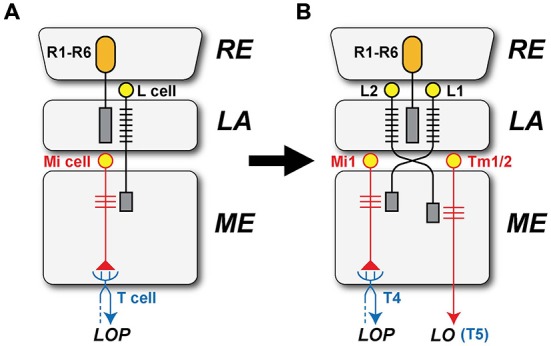Figure 6.

The separate origins of the L1 and L2 pathways. (A) L1 and L2 are proposed to have originated by a duplication event involving their innervation by photoreceptor axons derived from the retina (RE). In the ancestral form, only a single subtype of LA (L) cell is proposed to have received input from the photoreceptor cells (R1–R6) in the LA and provide output to the ME, later through the external chiasma. Ancestral unicolumnar Mi cells are shown as a target of the L-cell terminal in the ME, and these provide input to a single type of ancestral T-cell that transferred motion information from the ME to the LOP, in parallel with the segregation of separate T4 and T5 cells. (B) L1 retained an ancestral unicolumnar target neuron that became Mi1, together with multicolumnar neurons that transformed into Tm3 neurons after the ancestral combined neuropil split to yield separate ME and LO neuropils. The ancestral T-cell differentiated into T4 cells, which mediate signals in the L1 pathway. L2’s target neurons transformed into Tm cells, one undergoing a further duplication to yield paired unicolumnar neurons Tm1 and Tm2, and Tm4, which transformed from an ancestral multicolumnar Mi neuron. The Tm cells extended axons to the newly generated LO, providing input to the T5 cell.
